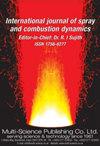模拟多相燃料液滴的伪势晶格-玻尔兹曼方法的评价
IF 2.1
4区 工程技术
Q3 ENGINEERING, MECHANICAL
International Journal of Spray and Combustion Dynamics
Pub Date : 2023-10-12
DOI:10.1177/17568277231202030
引用次数: 0
摘要
提出了一种改进的伪势格-玻尔兹曼模型来模拟燃料液滴的多相流动动力学,并与Peng-Robinson状态方程进行了热力学一致性测试。所研究的液体燃料包括具有不同碳原子数的石蜡烃(C[公式:见文]-C[公式:见文])、甲醇(CH[公式:见文]OH)、氢(H[公式:见文])、氨(NH[公式:见文])和水(H[公式:见文]O)。为了提高精度和减小杂散电流的大小,引入了多松弛次碰撞算子,并采用八阶各向同性的混合伪势相互作用力计算了作用力项。伪势晶格-玻尔兹曼模型准确地预测了平衡密度,并令人满意地捕获了彭-罗宾逊状态方程解析解给出的无中心因子范围为0.22 ~ 0.56的汽液共存热力学曲线,使液体和蒸汽分支的最大平均误差分别低于0.8%和3.7%。然而,Peng-Robinson被发现精度不足以复制实际的热力学状态,特别是对于H[公式:见文]O和CH[公式:见文]OH,其结果与实验汽液平衡密度有很大偏差,气相的平均误差接近28%。此外,使用多相伪势晶格-玻尔兹曼结果检索了表面张力(公式:见文本),并用于验证伪势晶格-玻尔兹曼相对于降落伞模型的热力学一致性。最后,伪势晶格-玻尔兹曼模型也被证明可以准确地预测振荡液滴的瞬态行为。总的来说,增强模型令人满意地预测了各种条件下物质的性质和行为。本文章由计算机程序翻译,如有差异,请以英文原文为准。
Assessment of the pseudopotential lattice-Boltzmann method for modeling multiphase fueldroplets
An improved pseudopotential lattice–Boltzmann model was proposed for simulating multiphase flow dynamics to describe fuel droplets, and its thermodynamic consistency was tested against the Peng–Robinson equation of state. The studied liquid fuels included paraffinic hydrocarbons with a different number of carbon atoms (C[Formula: see text]–C[Formula: see text]), methanol (CH[Formula: see text]OH), hydrogen (H[Formula: see text]), ammonia (NH[Formula: see text]), and water (H[Formula: see text]O). To improve accuracy and reduce the magnitude of the spurious currents, the multi-relaxation times collision operator was implemented and the forcing term was computed using the hybrid pseudopotential interaction force with an eighth-order isotropic degree. The pseudopotential lattice–Boltzmann model accurately predicted the equilibrium densities and captured satisfactorily the thermodynamic vapor-liquid coexistence curve given by the analytical solution of the Peng–Robinson equation of state for acentric factors ranging from [Formula: see text]0.22 to 0.56, keeping the maximum average error for the liquid and vapor branches below 0.8% and 3.7%, respectively. Nevertheless, Peng–Robinson was found to be insufficiently accurate to replicate the actual thermodynamic state, especially for H[Formula: see text]O and CH[Formula: see text]OH, for which the results strongly deviated from the experimental vapor-liquid equilibrium densities and reached average errors for the vapor phase of nearly 28%. Furthermore, the surface tension ([Formula: see text]) was retrieved using the multiphase pseudopotential lattice–Boltzmann results and served to verify the thermodynamic consistency of the pseudopotential lattice–Boltzmann with respect to the parachor model. Lastly, the pseudopotential lattice–Boltzmann model was also shown to predict accurately the transient behavior of oscillating droplets. Overall, the enhanced model satisfactorily predicted the properties and behavior of the substances for a wide range of conditions.
求助全文
通过发布文献求助,成功后即可免费获取论文全文。
去求助
来源期刊

International Journal of Spray and Combustion Dynamics
THERMODYNAMICS-ENGINEERING, MECHANICAL
CiteScore
2.20
自引率
12.50%
发文量
21
审稿时长
>12 weeks
期刊介绍:
International Journal of Spray and Combustion Dynamics is a peer-reviewed open access journal on fundamental and applied research in combustion and spray dynamics. Fundamental topics include advances in understanding unsteady combustion, combustion instability and noise, flame-acoustic interaction and its active and passive control, duct acoustics...
 求助内容:
求助内容: 应助结果提醒方式:
应助结果提醒方式:


